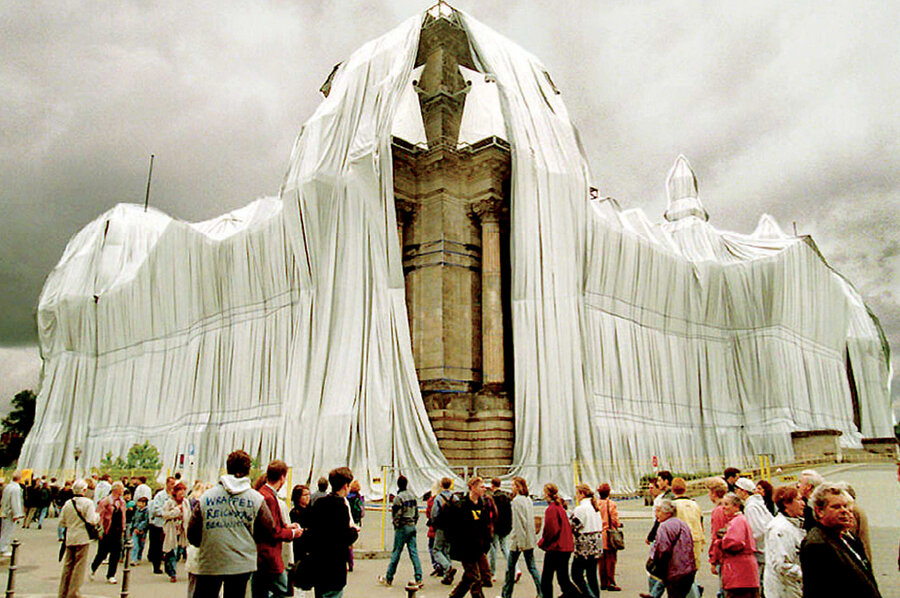Christo and the art of the moment
Loading...
Thank you, Christo. You helped me get over two big regrets in life.
Christo is the "wrapper" artist. He and his late wife, Jeanne-Claude, surrounded islands in Miami's Biscayne Bay with floating pink polypropylene and sheathed the Reichstag, the seat of the German parliament in Berlin, in a shimmering silver fabric.
Christo's work unexpectedly crossed my path in September 1985. Or rather, I crossed its path. I had traveled with my boyfriend, Mark, to visit relatives in Germany. A detour to Paris seemed like a grand idea. While there, we happened upon the wrapped Pont Neuf, a bridge covered from lamppost to footing in folds of camel-colored cloth.
I had never heard of Christo, but it was love at first sight. We loved his artwork for its size, grace, and color. How could something so big and solid as a stone bridge appear so soft? We loved the wrapping for its visual setting and its serendipity. And just like Mary Poppins, who jumped into Bert's sidewalk painting, we could literally step into this art.
Fast forward to February 1995. Christo gets permission to wrap the Reichstag in Berlin. By this time, Mark and I are married and live in California – our next landing place after working as journalists in Germany.
We discuss flying to Berlin, where we had both reported on the fall of the wall. I can't even remember what deterred us, but we shouldn't have let it. Ever since then, every time I have read about Christo and Jeanne-Claude, and even when Mark and I walked through their 2005 "Gates" project in New York's Central Park, the regret over the missed Reichstag visit has hammered my thoughts.
I felt similarly about another missed opportunity involving art. It was 1986, shortly before Mark and I got married. I was walking down Newbury Street in Boston's trendy Back Bay and happened upon a gallery selling lithographs by David Hockney.
Hockney is one of my favorite contemporary artists. My graphic-artist sister had introduced me to his Paper Pools, large works depicting outdoor swimming pools and made from paper pulp soaked with color.
The pool series set my swimmer's heart aflutter. I've been churning laps for years, following the bubbles left by the kicks of the person in front of me, and watching reflections and refractions of light. The lithographs included pool images and I desperately wanted one.
Each one sold for about $2,000. That was a lot of money back then, but doable – if I hadn't had the boneheaded notion that I must pay for my own wedding.
That meant I couldn't buy the Hockney. And with every Hockney exhibit, the lithograph-not-bought weighed on me.
But Christo taught me to appreciate the ephemeral.
His works are displayed for only a few weeks before they're dismantled. I remember an exhibit Mark and I saw a few years ago, on a yet-to-be completed Christo/Jeanne-Claude project: covering the Arkansas River in Colorado with a canopy.
That exhibit included gigantic sketches of the canopy from every possible angle. It featured the cables and footings to be used and a large swath of the sample fabric, as well as photographs from fieldwork.
Passing through the rooms was a near metaphysical experience. The idea of the project saturated me. It was so powerful that I felt as if I had seen the actual installation, even though I only saw a rendering of it.
Sometimes, my husband gives me a little lecture about appreciating the fleeting nature of something, such as a blooming dogwood tree or a dusting of fresh snow. You can't always own a thing, or hold on to it, he reminds me.
Intellectually, I know he's right. But when Christo said essentially the same thing in a documentary I saw this summer, it finally sunk in. The artist himself was reassuring me of beauty in the unexpected encounter with something that won't, to the physical eye, last.
"Do you know that I don't have any artworks that exist? They all go away when they're finished," he once said.
The artist couple wanted their works to have a profound impact on the viewer. They did on me – when I saw them, and when I didn't.
I still love the covered Pont Neuf, and now I love a wrapped Reichstag that no longer exists and that I never visited.





